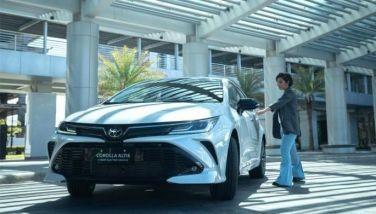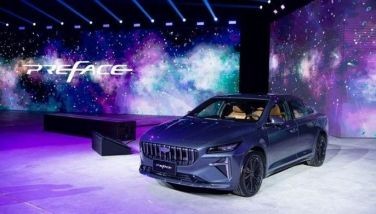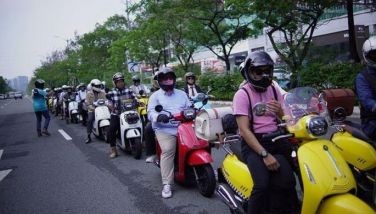Down the road
May 17, 2006 | 12:00am
I’m not an economist by profession, so I can’t give you any hard figures, but let me scare you a little with my backseat prophecy: in the next three years, the price of fuel will go up by another 50%. Maybe I took the movie Syriana a little too seriously, or maybe I’m becoming a little paranoid, but looking back at the dynamics of fuel price increases over the past several years, the elements have been consistent. A steady, increasing demand for oil worldwide, no significant oil finds to boost the world supply, persistent instability in the oil-exporting Middle East, and our genuine lack of realistic alternatives to fossil fueled transportation. For every price rollback, it seems that there’s been a gradual increase in the price of fuel a few months (or weeks) later.
Two years ago, a liter of unleaded gasoline cost what, P25? Now it’s a little below P40. We bitch and we whine and we moan every time we have to pay at the pumps, and we will continue to do so until there is a real, significant decrease in the demand for fuel. Contrary to what most people think of oil companies as heartless, capitalist multinationals who decree fuel prices with impunity, I think that they behave just like ordinary capitalists you’d see in your average neighborhood. If they impose too high an increase on fuel, there will be a drastic decrease in demand as consumers recoil from the price shock, and if that happens, they lose revenue. But if they implement a phased series of increases, the consumer feels only a gradual discomfort with some respite in between, but no change in his demand for the commodity. Only when the consumer looks back and realizes — egads! — that he’s already paying a small fortune for something that only cost as much as water only a couple of years ago will there be some negative impact in demand. What the oil company is doing, therefore, is a fine balancing act between protecting his revenue by passing on the added cost of oil to the consumer, and making sure that the consumer still buys his fuel in the first place.
So what can we, as consumers, do to avert these price increases? Honestly, nothing. We can conserve fuel all we want and buy fuel-efficient cars for a change, but there simply is no way to avoid fuel from putting a serious burn in our pockets. Let’s say that, regardless of your vehicle, you put in all the fuel-saving tricks you’ve read about here and in other publications and it netted you, on average, a 10% improvement in mileage. Since you’re not Pocholo Ramirez and you do most of you’re driving in the city, 10% is fantastic, right? If you get 450 kilometers out of one full tank, that’s another 45 you could use for your errands and Sunday trips with the kids. But that still hasn’t changed a fundamental element in the price cycle because you still go to the gas station on a weekly basis. You might have delayed the fuel-up by another day but the point is that you still have to go, and that is because there really is NO alternative for you but to use your fossil fuel car for the great majority of your transportation requirements.
I suppose you could ride a bicycle to work but… on second thought, you can’t. Believe me, I’ve tried it and it just doesn’t work unless it’s really your job to ride it for a living, or if your office is no more than 30 minutes riding time from the house, has a shower, and you don’t mind lugging office clothes to work every day. We urban denizens are so dependent on automobiles because there is no efficient and comfortable system of urban transportation. Contrast this with developed countries such as the US, Japan, and even Hong Kong. Fuel is even more expensive in those countries, but the majority of salaried workers are perfectly happy to commute to work by bus or by train. More affordable, more efficient, and you don’t have to worry about parking. Contrast this to the typical Makati-based worker.
For example, if you’re based in Salcedo side and have a business meeting in Greenbelt, do you walk? There will be those who don’t mind the mild exertion, but the majority either takes the car or flags a taxi. Contrast this with some train-riding experiences I had a couple of months ago. From Shinegawa district to Akihabara in Tokyo (roughly the distance from Makati to Quezon City), all I had to do was take a 10-minute train ride right outside my hotel. From Tsim Sha Tsui to Hong Kong island, it’s just a 15-minute subway ride. Both trips saved me around an hour of commuting by cab, not to mention a substantial saving in cash which I happily spent later on for shopping. Back in Manila, the trip from my house in Parañaque to the office in Quezon City is 35-kilometers one way. Using my car, it takes me around 70 minutes and around P230 in gas and toll, one-way. Were I to take the public transport system, I might save at least P100, but then the one-way trip would take at least two hours… and I’m not about to spend five hours of my life every day commuting. I’d never get any work done. Therefore, no matter what people say that fuel here is still cheaper than in other markets like Europe, the fact is that we require fuel on a personal basis more than the average consumer there. A European or a Japanese or a Chinese who takes the train to work will not feel the pinch as much as the average Filipino who must either drive the car or ride a fossil fuel-powered, public transportation vehicle.
So, now that I’ve convinced you that the price of fuel will go up even further, and in the process scaring myself as well with the prospect of high four-figure fuel bills not too far down the road, what can happen to lessen the pain? Affordable alternative fuel cars are still a long way off and we can forget about a super-efficient public transport system for the next twenty years, so the only real solution is, first, a change in our spending habits and second, the price of fuel reaches equilibrium where oil companies simply run out of willing consumers already.
That is, consumers will not be able to afford to gas up as frequently as they used to, and because they can’t, the price of fuel will finally stabilize. The first condition is already happening; buyers are shifting to fuel-efficient cars instead of gas-guzzling SUVs, there are fewer purchases for "luxury" goods and services among the middle-class, grocery purchases are shifting to cheaper house-brand generic labels, and there’s one less trip to the Starbucks for me, for example. These savings are then channeled into the unavoidable fuel purchase.
But the elements we can’t control such as the persistent (dare I say eternal?) fighting in the Middle East and in other oil-producing countries, a complete absence of significant oil finds that can be rapidly developed in the short term, and our near-complete dependence on fossil fuel will all contrive to raise fuel prices still higher until there’s more supply than there is demand. Drastic lifestyle changes will happen: carpooling will turn from an option now into a way of life, workers will opt to move closer to their places of employment (or change jobs), and usage of the car will be reserved for truly necessary trips while we use other means such as commuting or riding a motorcycle for the great majority of errands. Three years down the road, I’m willing to bet that we’ll look back at 2006 and say "Gas was really cheap at P40 to a liter then."
Here are some of your comments and recommendations from last week.
Hyundai Santa Fe made available in the Philippines ahead of the US? Please check WIRED Magazine December 2000 issue, page 125 or hyundaiUSA.com. Thanks. — 09207651825 (While it’s true that the Hyundai Santa Fe has been a staple variant in the US market for many years now, the 2.2L CRDi version and the new 2.7L gasoline version were indeed released first in the Philippines.)
Almost every night I count more than 20 vehicles with only one headlight, usually on bright mode. — 09176290974
I pass through Roxas Boulevard every day and it is always traffic along the Baywalk area because the stoplight for vehicles runs for a maximum time of 40-60 seconds. — 09209269180
The LTO should physically inspect all kinds of vehicles before renewing their permits. Most are not road worthy. — 09064747103
May I request our authorities to apprehend jeepney drivers who don’t use their headlights at night? Also reckless pedicab drivers and modified motorcycles. — 09202332911
Speak out, be heard and keep those text messages coming in. To say your piece and become a "Backseat Driver", text PHILSTAR<space>FB<space>MOTORING<space>YOUR MESSAGE and send to 2840 if you’re a Globe or Touch Mobile subscriber or 334 if you’re a Smart or Talk ’n Text subscriber or 2840 if you’re a Sun Cellular subscriber. Please keep your messages down to a manageable 160 characters. You may send a series of comments using the same parameters.
Two years ago, a liter of unleaded gasoline cost what, P25? Now it’s a little below P40. We bitch and we whine and we moan every time we have to pay at the pumps, and we will continue to do so until there is a real, significant decrease in the demand for fuel. Contrary to what most people think of oil companies as heartless, capitalist multinationals who decree fuel prices with impunity, I think that they behave just like ordinary capitalists you’d see in your average neighborhood. If they impose too high an increase on fuel, there will be a drastic decrease in demand as consumers recoil from the price shock, and if that happens, they lose revenue. But if they implement a phased series of increases, the consumer feels only a gradual discomfort with some respite in between, but no change in his demand for the commodity. Only when the consumer looks back and realizes — egads! — that he’s already paying a small fortune for something that only cost as much as water only a couple of years ago will there be some negative impact in demand. What the oil company is doing, therefore, is a fine balancing act between protecting his revenue by passing on the added cost of oil to the consumer, and making sure that the consumer still buys his fuel in the first place.
So what can we, as consumers, do to avert these price increases? Honestly, nothing. We can conserve fuel all we want and buy fuel-efficient cars for a change, but there simply is no way to avoid fuel from putting a serious burn in our pockets. Let’s say that, regardless of your vehicle, you put in all the fuel-saving tricks you’ve read about here and in other publications and it netted you, on average, a 10% improvement in mileage. Since you’re not Pocholo Ramirez and you do most of you’re driving in the city, 10% is fantastic, right? If you get 450 kilometers out of one full tank, that’s another 45 you could use for your errands and Sunday trips with the kids. But that still hasn’t changed a fundamental element in the price cycle because you still go to the gas station on a weekly basis. You might have delayed the fuel-up by another day but the point is that you still have to go, and that is because there really is NO alternative for you but to use your fossil fuel car for the great majority of your transportation requirements.
I suppose you could ride a bicycle to work but… on second thought, you can’t. Believe me, I’ve tried it and it just doesn’t work unless it’s really your job to ride it for a living, or if your office is no more than 30 minutes riding time from the house, has a shower, and you don’t mind lugging office clothes to work every day. We urban denizens are so dependent on automobiles because there is no efficient and comfortable system of urban transportation. Contrast this with developed countries such as the US, Japan, and even Hong Kong. Fuel is even more expensive in those countries, but the majority of salaried workers are perfectly happy to commute to work by bus or by train. More affordable, more efficient, and you don’t have to worry about parking. Contrast this to the typical Makati-based worker.
For example, if you’re based in Salcedo side and have a business meeting in Greenbelt, do you walk? There will be those who don’t mind the mild exertion, but the majority either takes the car or flags a taxi. Contrast this with some train-riding experiences I had a couple of months ago. From Shinegawa district to Akihabara in Tokyo (roughly the distance from Makati to Quezon City), all I had to do was take a 10-minute train ride right outside my hotel. From Tsim Sha Tsui to Hong Kong island, it’s just a 15-minute subway ride. Both trips saved me around an hour of commuting by cab, not to mention a substantial saving in cash which I happily spent later on for shopping. Back in Manila, the trip from my house in Parañaque to the office in Quezon City is 35-kilometers one way. Using my car, it takes me around 70 minutes and around P230 in gas and toll, one-way. Were I to take the public transport system, I might save at least P100, but then the one-way trip would take at least two hours… and I’m not about to spend five hours of my life every day commuting. I’d never get any work done. Therefore, no matter what people say that fuel here is still cheaper than in other markets like Europe, the fact is that we require fuel on a personal basis more than the average consumer there. A European or a Japanese or a Chinese who takes the train to work will not feel the pinch as much as the average Filipino who must either drive the car or ride a fossil fuel-powered, public transportation vehicle.
So, now that I’ve convinced you that the price of fuel will go up even further, and in the process scaring myself as well with the prospect of high four-figure fuel bills not too far down the road, what can happen to lessen the pain? Affordable alternative fuel cars are still a long way off and we can forget about a super-efficient public transport system for the next twenty years, so the only real solution is, first, a change in our spending habits and second, the price of fuel reaches equilibrium where oil companies simply run out of willing consumers already.
That is, consumers will not be able to afford to gas up as frequently as they used to, and because they can’t, the price of fuel will finally stabilize. The first condition is already happening; buyers are shifting to fuel-efficient cars instead of gas-guzzling SUVs, there are fewer purchases for "luxury" goods and services among the middle-class, grocery purchases are shifting to cheaper house-brand generic labels, and there’s one less trip to the Starbucks for me, for example. These savings are then channeled into the unavoidable fuel purchase.
But the elements we can’t control such as the persistent (dare I say eternal?) fighting in the Middle East and in other oil-producing countries, a complete absence of significant oil finds that can be rapidly developed in the short term, and our near-complete dependence on fossil fuel will all contrive to raise fuel prices still higher until there’s more supply than there is demand. Drastic lifestyle changes will happen: carpooling will turn from an option now into a way of life, workers will opt to move closer to their places of employment (or change jobs), and usage of the car will be reserved for truly necessary trips while we use other means such as commuting or riding a motorcycle for the great majority of errands. Three years down the road, I’m willing to bet that we’ll look back at 2006 and say "Gas was really cheap at P40 to a liter then."
Here are some of your comments and recommendations from last week.
Hyundai Santa Fe made available in the Philippines ahead of the US? Please check WIRED Magazine December 2000 issue, page 125 or hyundaiUSA.com. Thanks. — 09207651825 (While it’s true that the Hyundai Santa Fe has been a staple variant in the US market for many years now, the 2.2L CRDi version and the new 2.7L gasoline version were indeed released first in the Philippines.)
Almost every night I count more than 20 vehicles with only one headlight, usually on bright mode. — 09176290974
I pass through Roxas Boulevard every day and it is always traffic along the Baywalk area because the stoplight for vehicles runs for a maximum time of 40-60 seconds. — 09209269180
The LTO should physically inspect all kinds of vehicles before renewing their permits. Most are not road worthy. — 09064747103
May I request our authorities to apprehend jeepney drivers who don’t use their headlights at night? Also reckless pedicab drivers and modified motorcycles. — 09202332911
Speak out, be heard and keep those text messages coming in. To say your piece and become a "Backseat Driver", text PHILSTAR<space>FB<space>MOTORING<space>YOUR MESSAGE and send to 2840 if you’re a Globe or Touch Mobile subscriber or 334 if you’re a Smart or Talk ’n Text subscriber or 2840 if you’re a Sun Cellular subscriber. Please keep your messages down to a manageable 160 characters. You may send a series of comments using the same parameters.
BrandSpace Articles
<
>
- Latest
Latest
Latest
September 30, 2024 - 4:26pm
By EC Toledo | September 30, 2024 - 4:26pm
September 26, 2024 - 3:30pm
September 26, 2024 - 3:30pm
August 16, 2024 - 11:00am
By Euden Valdez | August 16, 2024 - 11:00am
Recommended





























